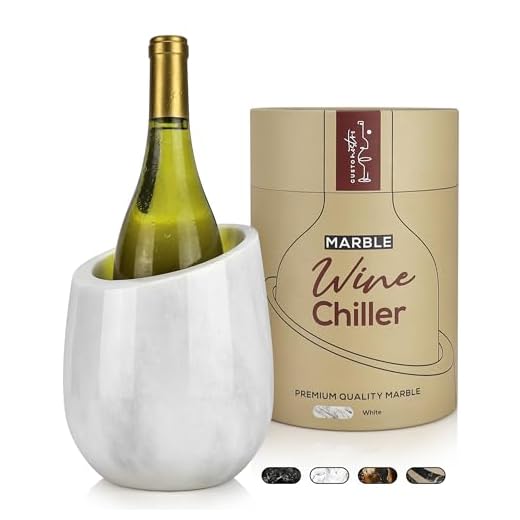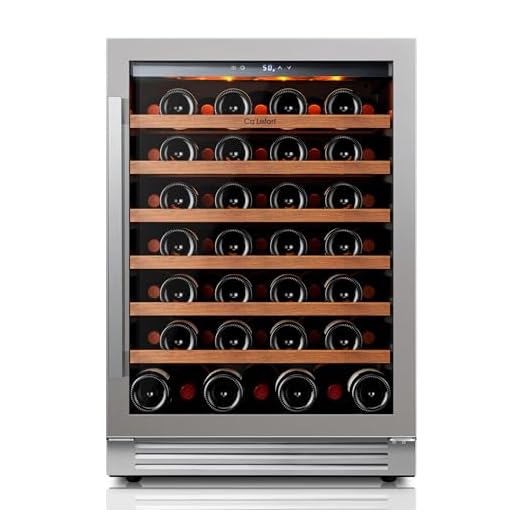



Chilling this delightful beverage to a temperature between 45°F and 55°F (7°C to 13°C) enhances its refreshing qualities and aromatic profile. Storing it in a cool environment is preferred, ensuring a crisp and invigorating experience upon serving.
For those seeking the best flavor expression, a brief period in a standard refrigerator or an ice bucket can achieve the ideal serving temperature. Avoid prolonged exposure to cold temperatures, as excessive chilling may mute the intricate flavors and aromas that make this drink stand out.
When planning to enjoy a glass, consider the varietal and style. Lighter, fruit-forward options benefit from being served towards the lower end of the temperature spectrum, while fuller-bodied selections can be served slightly warmer to reveal their complexity. Knowledge of these nuances can elevate the tasting experience significantly.
Do You Refrigerate Rose Wine?
Chilling this type of beverage is highly recommended. The ideal serving temperature ranges from 45°F to 55°F (7°C to 13°C), enhancing the refreshing qualities and flavors. Placing it in a cooler or refrigerator for a few hours before serving will bring out the best in its taste profile.
Optimal Serving Techniques
Utilizing an ice bucket with a mix of ice and water can achieve rapid cooling. Immerse the bottle for about 20 minutes for an optimal temperature. Avoid prolonged exposure to extreme cold, as it may mask the complexities of the flavors.
Storage Tips
Long-term storage should be in a cool, dark place, ideally between 50°F to 55°F (10°C to 13°C). Once opened, consumption within a few days is advisable. If not consumed, a brief chill in the fridge can preserve its qualities for a short period.
Optimal Temperature for Storing Rosé Wine
For storing this delightful beverage, the ideal temperature ranges from 45°F to 55°F (7°C to 13°C). Maintaining this temperature range helps preserve the delicate aromas and flavors, allowing for an enjoyable tasting experience.
Long-Term Storage
For extended periods, a cool, dark place is preferred. A dedicated cellar or wine fridge with controlled temperature will provide the best conditions. Avoid fluctuations that can adversely affect the quality.
Short-Term Storage
When consuming soon after purchase, placing the bottle in a cooler for a couple of hours before serving is advisable. This ensures a refreshing, crisp profile, enhancing the overall enjoyment. Always allow for a brief resting period before serving to optimize the tasting experience.
Monitoring humidity levels is also beneficial; around 70% humidity is ideal to prevent corks from drying out, which can lead to oxidation. Keep bottles stored horizontally to maintain contact between the cork and liquid.
How Long Can Rose Wine Be Left Out of the Fridge?
When stored outside refrigeration, a bottle of pink drink maintains its quality for approximately 4 to 6 hours at room temperature. After this period, the flavors may begin to degrade, and the overall experience can diminish significantly.
For optimal enjoyment, it’s advisable to consume the beverage shortly after removal from a cooler. If the ambient temperature exceeds 70°F (21°C), the risk of spoilage increases, and it’s best to return the bottle to a cooler environment to preserve its integrity.
| Temperature (°F) | Recommended Time Outside |
|---|---|
| Below 60°F (15°C) | Up to 8 hours |
| 60°F – 70°F (15°C – 21°C) | 4 – 6 hours |
| Above 70°F (21°C) | 2 – 3 hours |
Once opened, the bottle should ideally be consumed within a couple of days for the best taste. Resealing with a cork or a wine stopper and storing in a cool, dark place can help maintain flavor for a short duration.
Signs That Rosé Has Spoiled
A change in color can indicate spoilage; a brownish hue suggests oxidation. Fresh pink shades should be the benchmark.
Off-putting odors, such as vinegar-like or musty scents, are clear indicators of deterioration. A pleasant, fruity aroma is essential for quality.
Taste is another significant factor. A sour or overly flat flavor profile points to spoilage. Quality should be crisp and refreshing.
Cloudiness or sediment in the liquid can also suggest that the beverage has gone bad. Clarity is key for a well-preserved product.
Lastly, an unusual fizz in a still product may signal fermentation or contamination. Effervescence should be absent unless specifically intended.
Best Practices for Chilling Rosé Wine
For optimal enjoyment, a chilled beverage should reach a temperature between 45°F to 55°F (7°C to 13°C). To achieve this, consider the following methods:
Ice Bath Method
- Fill a bucket with equal parts ice and water.
- Submerge the bottle for about 20-30 minutes.
- This method ensures rapid cooling without risking freezing.
Refrigeration Tips
- If using a refrigerator, place the bottle in the coldest section for 2-3 hours prior to serving.
- A wine chiller can also be effective, cooling the bottle in approximately 15-20 minutes.
Avoid excessive chilling, as it can mute the flavors and aromas. Always assess the temperature before serving. For those curious about culinary timing, check out how long does it take to cook smoked turkey necks for a delicious pairing opportunity.
Remember to serve in appropriate glassware to enhance the tasting experience. A tulip-shaped glass is ideal for capturing the bouquet while allowing for ample aeration.
Pairing Rosé with Food: Temperature Considerations
Serving temperature significantly influences the experience of enjoying this delightful beverage alongside meals. Aim for a temperature between 45°F to 55°F (7°C to 13°C) for optimal enjoyment. This range enhances the aromas and flavors, allowing for a more harmonious pairing with various dishes.
Ideal Pairings by Temperature
At the lower end of the spectrum, around 45°F (7°C), the drink complements light salads, seafood, and fresh appetizers beautifully. The crispness cuts through the richness of creamy dressings and buttery sauces. As the temperature rises to 55°F (13°C), more robust flavors can shine, making it suitable for grilled meats, hearty pasta dishes, and even certain cheeses.
Common Pairing Suggestions
Lightly chilled options work well with dishes like grilled shrimp tacos or a fresh Caprese salad. As the temperature increases, consider pairing with roasted vegetable medleys or chicken piccata, where the flavors meld together seamlessly. The cooling effect can enhance spicy dishes, balancing heat and bringing out underlying flavors.
Take note of the food’s characteristics when selecting a temperature. The goal is to create a balance between the dish and the drink, ensuring neither overpowers the other. Adjusting temperature slightly can elevate the overall dining experience.
How to Properly Store Opened Rosé Wine
Seal the bottle tightly with its original cork or a reusable stopper. This minimizes oxidation and preserves freshness. Store the sealed bottle upright to reduce the wine’s exposure to air. A dark place is ideal; UV light can degrade flavors.
Maintain a consistent cool temperature, ideally between 45°F and 55°F (7°C to 13°C). Avoid temperature fluctuations, which can negatively impact taste and aroma. If a wine cooler is available, it serves as an excellent storage solution.
Opened bottles are best consumed within three to five days for optimal flavor. After this period, the taste may begin to deteriorate. Check for any signs of spoilage before consumption, such as an off smell or a change in color.
For short-term storage, a refrigerator is suitable, as it slows down the oxidation process. If planning to enjoy the remaining contents later, returning the bottle to a cooler environment is advisable.
Regularly assess the wine before drinking. If it has developed a vinegar-like aroma or an unusual taste, it is best to discard the bottle. Keeping track of how long a bottle has been open ensures that only the freshest and most enjoyable experience is savored.
Comparing Rosé to Other Types of Wine Storage Needs
When it comes to storage, different varieties of fermented grape beverages have distinct requirements. Rosé necessitates a cooler environment than many red options, yet it does not need the same level of chill as whites. Understanding these nuances can enhance the experience of enjoying each type.
Storage Temperatures
- Light Reds: Generally, these are best stored at slightly warmer temperatures, around 55°F to 65°F (13°C to 18°C). This allows the subtle flavors to develop without being overpowered by the chill.
- Full-Bodied Reds: These often thrive at 60°F to 65°F (15°C to 18°C). A cooler storage can mute complex aromas and flavors that these wines offer.
- Whites and Sparklings: Typically require a cooler environment, ideally between 45°F to 55°F (7°C to 13°C). This crispness accentuates the refreshing qualities that characterize these beverages.
- Rosé: Best kept at a temperature of 50°F to 55°F (10°C to 13°C), striking a balance between the two extremes.
Duration of Shelf Life
- Light Reds: Often enjoyed sooner, they can last around 2 to 3 years if stored properly.
- Full-Bodied Reds: With good aging potential, these can last anywhere from 5 to 10 years, depending on the specific varietal.
- Whites and Sparklings: Generally, these are intended for earlier consumption, typically within 1 to 3 years.
- Rosé: This variety is best enjoyed fresh, ideally within 1 to 2 years after bottling.
By tailoring storage practices to the specific needs of each type, the full expression of flavors can be appreciated. Observing these guidelines will ensure that every glass served is at its optimum quality.








